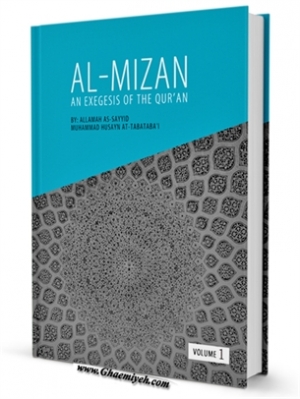Almizan is an Arabic exegesis of the Quran in 20 volumes which is written by Allame Mohammad Hussein Tabatabayi.
Since the time he started teaching in Howze-elmiyeh of Qom, he had the motivation of beginning of an exegesis. Eventually it was begun by insistence of his students.
Writing of this book lasted 17 years from1333 to 1350 (lunar month).
Structure
The first volume contains a preface written by the author and the interpretation of surah Hamd and 182 verses of surah Baqarah(the cow), and the other volumes explain and interpret the other sections of Quran.
Contents
This book is known as one of the main and significant resource of Islamic culture and teaching in last century. It is indeed a comprehensive collection involving deep Quranic, hadith, philosophical, mystical, literature, ethical, historic, social, etc matters which are gathered in an innovative and researching way. This exegesis has unique features that could not be found over the history of interpretation of Quran including: external and spiritual aspects, caring of correct Quranic measures, differentiating between different methods of exegesis, criticizing other ideas and so on.
Allame Tabatabayi after investigating different methods of interpretation concludes that all these methods have a significant short-coming and that is imposing the results of philosophical and scientific matters which are out of the meaning of verses and in this case exegesis loses its concept and that would be adapting rather than interpreting, and plenty of Quran's facts would be ignored and some verses, misunderstood.
The author in the preface takes a look at the history and methods of interpretation. He states his attitude about exegesis and the method he follows, and mentions the huge difference of his method with other groups of interpreters and criticize and refuse them such as Akhbariha who invalidate our understanding from Quran and limits interpretation through traditions and they go further and come to this belief that the Quran is not understandable for us. The writer believes that the method of Ahlelbayt to interpret is exegesis of Quran by its own and in this case refers to different samples in his book.
Method of Allame Tabatabayi
The author's manner in his exegesis is that firstly mentions some verses of surah and afterwards starts a part titled explanation of verses (Bayane Ayat) that consists of matters attributed to subjects of the verses. In this part there are literal and literary matters and explains the meaning of verses regarding similar verses and mentions the meanings understood implicitly. In the next part narrates traditions and in some cases criticizes. Different Shia and Sunni sources are used. Moreover independent subjects are significant; because deep and boarded issues in theology, philosophy, ethic, Quranic lessons, jurisprudence and social matters are argued.
Allame himself in the preface of his book mentions a condensed conclusion as the result of his interpretation:
Teachings attributed to names and features of God such as life, knowledge.
Teachings attributed to God's actions like creating, order, wanting, leading.
Teachings attributed to means between God and human beings like hijabs, Loh, Arsh.
Human beings before the world
Teachings about human in this world like history of human beings, knowing human, knowing social rules, prophecy, revelation, Quran, religion.
Teachings attributed to human beings of after this world; Barzakh and hereafter
Teachings about ethics
In the following of each part there are various narrations of prophet and his progeny from Shia and Sunni sources and has stated philosophical, scientific, historic, social and ethical subjects.
The author does not argue about jurist verses.
Status of the book
The Persian translation of this book is written by a group of scholars -in Howze of Qom in 40 volumes- who are Naser Makarem Shirazi, Mohammad Javad Kermani, Mohammad Taghi Mesbah Yazdi, Mohammad Reza Salehi Kermani, Seyyed Mohammad Khamenie, Abdlolkarim Borujerdi. And there is another translation in 20 volumes done by Mohammad Bagher Mosavi Hamedani.
Almizan has also translation in other languages such as English, Urdu, Turkish and Spanish. The English translation starts from the beginning until the 76th verse of Surah Nissa.
There is a summary translation of Almizan done by Fatimah Mashayekh. This book starts from Surah A'araf and ends by Surah Hud. The author has tried to include the main issues of Almizan for youths.
